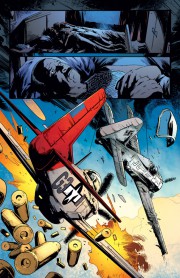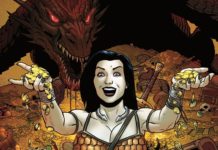Garth Ennis: Dreaming Eagles tells the story of the Tuskegee Airmen, the black fighter pilots who overcame a good deal of bigotry to fly for the US Army Air Force during WW2. In the mid 1960s veteran Reggie Atkinson tells his son Lee the story of their recruitment and training in 1942, followed by their overseas deployment to Tunisia and Italy. Initially only a single squadron, the 99th, the Tuskegee pilots eventually form the 332nd Fighter Group. After a lot of dangerous and unrewarding ground-attack work they’re given the very best fighters available, and assigned to escort American bomber squadrons on their missions deep inside Nazi Germany.
G.E.: I find the Second World War a particularly fascinating period for a number of reasons. First, the stakes are so high, with Democracy, Communism and Fascism locked in a battle to the death, and the eventual outcome shaping the world to come. Second, I’m a particular fan of the hardware of the era, particularly in terms of aircraft. Lastly, and this applies to all wars, I find the true life accounts of experience on the very knife-edge of human existence absolutely fascinating, far more so than any kind of fantasy fiction. Regarding Dreaming Eagles in particular, what I find interesting about the Tuskegee story is that black people are being given the opportunity to fight, kill and die for their country- a country that has frankly not been kind to them.
G.E.: Joe Pruett got in touch with me- I’ve known Joe for a long time, and I trust his judgment when it comes to things like this. Beyond that AfterShock gave me the deal I wanted. Mike Marts being aboard certainly helped; it’s reassuring to be able to work with competent people on the day–to-day stuff.



G.E.: I thought that one up pretty quickly; editor Nick Lowe suggested taking the character from the previous Phantom Eagle miniseries I did with Howard Chaykin, and putting him in a «lost world» setting with dinosaurs and so on. I thought that would be fun, something I was in the mood for at the time. I knew what sort of restrictions I’d be writing under so had no real worries there, given that it was only five issues- as a matter of fact, I was surprised at a lot of the stuff that actually got through. My only real complaint would be that I wrote a story called «The Phantom Eagle Flies The Savage Skies» only for it to be published as «Where Monsters Dwell», something I wasn’t consulted about. Not a huge deal, really, but it’s that sort of thing that means I’ll only ever do so much work for the mainstream.
G.E.: He can draw aeroplanes damn well, essentially. I actually worked with Simon about 25 years ago, during my bloody awful run on Judge Dredd. He’s one of a number of artists from that time that I’ve since owed a much better script to. Hopefully this is it.
![]() AfterShock Comics
AfterShock Comics
![]() Interview with Brian Azzarello in Zona Negativa.
Interview with Brian Azzarello in Zona Negativa.
![]() Interview with Garth Ennis in Zona Negativa.
Interview with Garth Ennis in Zona Negativa.
![]() Interview with David Hine in Zona Negativa.
Interview with David Hine in Zona Negativa.
![]() Interview with Justin Jordan in Zona Negativa.
Interview with Justin Jordan in Zona Negativa.
![]() Interview with Amanda Conner and Jimmy Palmiotti in Zona Negativa.
Interview with Amanda Conner and Jimmy Palmiotti in Zona Negativa.
![]() Interview with Mike Marts in Zona Negativa.
Interview with Mike Marts in Zona Negativa.










